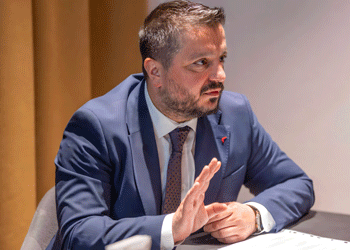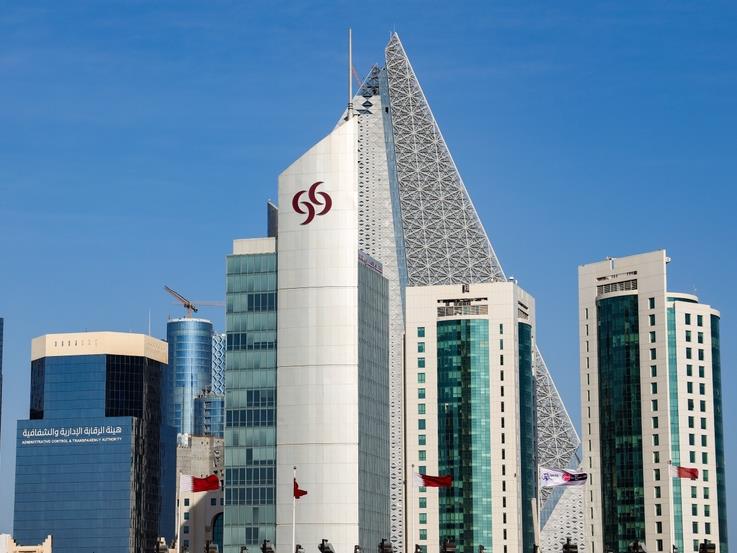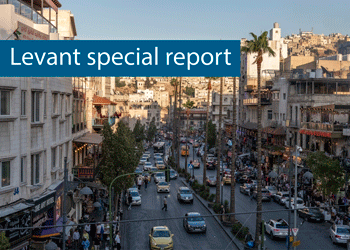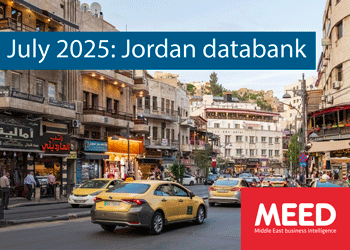Power sector awards momentum accelerates
26 December 2024

The Middle East and North Africa (Mena) region’s power sector awarded over $60bn of contracts between January and early November 2024, up 47.5% compared to the value of awarded contracts in the previous full year.
This figure is more than double the average value of annual contract awards recorded between 2014 and 2023, based on data from regional projects tracker MEED Projects.
 It also exceeds by 21% the total combined value of contracts awarded between 2018 and 2020, when some regional governments and utilities began pivoting to renewable energy and freezing the expansion of thermal plant capacities, in line with goals aimed at decarbonising their electricity systems.
It also exceeds by 21% the total combined value of contracts awarded between 2018 and 2020, when some regional governments and utilities began pivoting to renewable energy and freezing the expansion of thermal plant capacities, in line with goals aimed at decarbonising their electricity systems.
In 2020, the Covid-19 pandemic slowed down project activity and temporarily delayed the awarding of some contracts.
The market staged a short-lived comeback in 2021, when Saudi Arabia awarded a string of contracts for solar photovoltaic (PV) independent power projects (IPPs), including a contract to develop the 600MW Shoaiba solar PV scheme, which holds the world record for the lowest unsubsidised solar PV production at $cents1.04 a kilowatt-hour.
A slight contraction occurred the following year due to a spike in raw materials and engineering, procurement and construction (EPC) costs.
Last year saw a stunning recovery, however, helped by the award of new renewable energy projects in Saudi Arabia, the UAE, Egypt and Oman, as well as by a resumption of contract awards for new gas-fired power plants, particularly in Saudi Arabia, Libya and Iraq.
Yet 2024 is set to outshine 2023 in terms of awarded contracts for thermal, renewable energy and nuclear power generation plants, as well as for power transmission and distribution (T&D) infrastructure such as substations and overhead transmission lines.
Major 2024 awards
In 2023, power generation projects accounted for an estimated 79% of total contract awards, with T&D projects accounting for the rest.
A different picture is emerging in 2024, with data in the first nine months of the year suggesting that generation contract awards are retreating to about 64% of the total. This is due to increased T&D capital spending that has so far driven a 150% increase in award value compared to full-year 2023.
This is a clear indicator of T&D capacity buildout catching up with the generation capacity expansion, especially as larger economies such as Saudi Arabia strive to set up stronger and more efficient electricity links domestically, and as the energy-rich GCC states seek to establish stronger electricity links with one another and with their neighbours, including Egypt, Iraq and Jordan.
Saudi Arabia has dominated the overall Mena power contracts landscape. Its share of 29% in 2022 soared to 61% in 2023 and 67% in the first 10-11 months of 2024.
In May, principal buyer Saudi Power Procurement Company (SPPC) signed two power-purchase agreements with Japan’s Marubeni Corporation for contracts to develop two wind IPPs under the fourth round of the National Renewable Energy Programme (NREP). The Al-Ghat and Waad Al-Shamal wind IPPs have a total combined capacity of 1,100MW.
The contract for a third wind IPP, tendered as part of round four of the NREP, is also expected to be awarded soon.
In June, Saudi sovereign wealth vehicle the Public Investment Fund (PIF) let the fourth batch of solar PV schemes, which it is implementing bilaterally through the Price Discovery Scheme.
A team comprising Acwa Power, PIF-backed Water & Electricity Holding Company (Badeel) and Saudi Aramco Power Company (Sapco), a subsidiary of the state majority-owned oil giant Saudi Aramco, will develop the three solar projects, which will have a total combined capacity of 5,500MW and will require an investment of about $3.3bn.
The Haden solar PV and Muwayh solar power plants, which will each have a capacity of 2,000MW, will be located in Saudi Arabia’s Mecca region. The third project, the 1,500MW Al-Khushaybi solar PV plant, will be located in the Qassim region. The three new solar PV facilities are expected to become operational in the first half of 2027.
In early November, SPPC also announced the winning bidders for the contracts to develop four combined-cycle gas turbine plants comprising the second batch of thermal capacity that it has tendered since 2023. The four plants, located in Riyadh and the Eastern Province, will each have a capacity of 1,800MW and will require an investment of about $2bn each.
A developer consortium comprising the UAE-based Abu Dhabi National Energy Company (Taqa), Japan’s Jera Company and the local Albawani Company successfully bid for the contracts to develop and operate the Rumah 2 and Nairiyah 2 IPPs. Meanwhile, Saudi Electricity Company (SEC), Riyadh-based utility developer Acwa Power and South Korea’s Korea Electric Power Corporation (Kepco) won the contracts to develop and operate the similarly configured Rumah 1 and Nairiyah 1 IPPs.
State utility SEC is also understood to have issued the limited notices to proceed for six greenfield thermal power plants with a total combined capacity of over 16,000MW.
Power generation projects for which final contracts are expected to be awarded before the end of 2024 include:
- Hajr: 3,600MW
- Marjan: 1,800MW
- Riyadh PP12: 1,800MW
- Qurayyah: 3,600MW
- Ghazlan 1: 2,400MW
- Ghazlan 2: 2,900MW
The $5.3bn high-voltage direct current network project connecting the central, western and southern regions of Saudi Arabia was the single largest power contract awarded in Saudi Arabia in 2024.
The UAE, meanwhile, has awarded three key power contracts this year, including for the Al-Ajban solar IPP, which was won by a team of France’s EDF and South Korea’s Korea Western Power Company (Kowepo), and for the Dhafra waste-to-energy project, which a team of Japan’s Marubeni Corporation, Japan Overseas Infrastructure Investment Corporation and Zurich-headquartered Hitachi Zosen Inova is developing.
Dubai Electricity & Water Authority (Dewa) is also understood to have awarded the contract to complete the Jebel Ali K-Station to Egypt-based Power Generation Engineering & Services Company.
 2025 outlook
2025 outlook
The Mena power projects pipeline remains robust, with over $45bn-worth of contracts under bid evaluation and another $50bn in the prequalification stage as of late 2024, according to MEED Projects.
Saudi Arabia is likely to remain dominant, particularly if SPPC and the PIF activate a plan by the Energy Ministry to procure 20,000MW of renewable energy capacity annually until it reaches its target for renewables to account for half of its energy production mix by 2030.
Morocco has the second-largest power projects pipeline thanks to several planned schemes to export clean energy and green hydrogen to Europe. Notably, the tender is under way for the country’s first two solar PV plus battery energy storage system (bess) projects, Noor Midelt 2 and 3.
Abu Dhabi also maintains a substantial renewables and gas-fired generation project pipeline. It has several upcoming IPPs with a total combined capacity of over 7,000MW, of which more than 6,000MW is in the tendering stage.
While the procurement process for Saudi Arabia’s first nuclear power plant in Duwaiheen has been delayed, the UAE has plans to procure the next phase of its nuclear power plant project in Barakah.
Green industrial development in steel and aluminium, as is being undertaken in the UAE, is a driver for ongoing clean energy capacity buildout, notes Karen Young, senior research scholar at Columbia University’s Centre on Global Energy Policy.
Egypt, Iran, Kuwait and Iraq have the next largest power projects pipelines. The key drivers in each state vary, with populous countries Egypt and Iran seeking to develop integrated green hydrogen hubs and nuclear power capacity, respectively, while Kuwait remains a promising market with extended plans to procure both conventional and renewable energy capacity to address peak demand.
There are indications that Iraq’s first utility-scale solar PV scheme – a 1GW project being developed by France’s TotalEnergies – will head into the construction stage in the coming months, along with other similar projects for which preliminary agreements were signed by Iraqi authorities in 2021-22.
Oman is actively pursuing renewable energy capacity, with the state offtaker having tendered the contracts for two wind IPPs in September 2024.
In Oman and Qatar, the main downstream companies, Petroleum Development Oman and QatarEnergy, are developing renewable energy capacity as a means of mitigating their greenhouse gas emissions, as well as to support their respective government’s net-zero targets.
In November, Bahrain started the procurement process for its fourth independent water and power project (IWPP) in Sitra, which replaced the previously planned Al-Dur IWPP 3 scheme.

Other trends
SEC affiliate National Grid Saudi Arabia has awarded EPC contracts for several bess packages to local firm Algihaz this year. In August, it tendered a contract for the construction of a further 2,500MW of energy storage capacity.
In parallel, the procurement process is under way for the first independent bess packages in Saudi Arabia and Abu Dhabi, with other utilities expected to follow suit in procuring bess using an IPP model. Bess will boost grid flexibility and spinning reserves in the face of increased renewable energy capacity and demand.
In addition to bess and several gigawatts of solar and wind capacity, Saudi Arabia gigaproject developer Neom, which plans to be powered 100% by renewable energy by the end of the decade, is also considering a network of large-scale pumped hydropower storage plants.
However, despite the ongoing capacity buildout across the Mena states, some end-users – particularly in fossil fuel-
scarce jurisdictions such as Morocco – continue to struggle with supply.
“I’ve been part of a research project in Morocco looking at the renewable power landscape and green economy more broadly. In that case, we do see massive buildout, but it is tailored for offtake to state-related industrials,” says Columbia University’s Young.
She adds that a telephone survey of 1,000 small and medium-sized businesses in Morocco about their perception of the accessibility and affordability of renewable energy yielded surprising results.
“They strongly suggested a lack of support, given that smaller enterprises continue to see power outages and this has in many cases caused damage to their equipment and abilities to stay open and service customers.
“The disconnect between power buildout and industrial advances in a green supply chain and how small and medium firms see power accessibility and reliability is very stark. In a Mena-wide sense, we might start to question how the delivery and transmission of power in an equitable way affects economic growth opportunities overall.”
Exclusive from Meed
-
 Turkish Airlines plans further growth
Turkish Airlines plans further growth1 July 2025
-

-

-
 Levant states wrestle regional pressures
Levant states wrestle regional pressures1 July 2025
-
 Jordan’s economy holds pace, for now
Jordan’s economy holds pace, for now1 July 2025
All of this is only 1% of what MEED.com has to offer
Subscribe now and unlock all the 153,671 articles on MEED.com
- All the latest news, data, and market intelligence across MENA at your fingerprints
- First-hand updates and inside information on projects, clients and competitors that matter to you
- 20 years' archive of information, data, and news for you to access at your convenience
- Strategize to succeed and minimise risks with timely analysis of current and future market trends

Related Articles
-
 Turkish Airlines plans further growth
Turkish Airlines plans further growth1 July 2025
 This package on UAE-Turkiye relations also includes:
This package on UAE-Turkiye relations also includes:> UAE-Turkiye trade gains momentum
> Turkiye’s Kalyon goes global
> UAE-Turkiye financial links strengthen

With a network covering 30 more countries than its closest competitor, Turkish Airlines has been recognised by Guinness World Records for the most countries flown to by an airline since 2012. “Over the past two decades, Turkish Airlines has experienced rapid expansion, becoming one of the world’s most recognised airlines and the largest carrier in terms of destinations served,” says Erol Senol, vice-president of sales at Turkish Airlines.
The airline’s growth has meant it has become a competitor for the major Gulf carriers such as Emirates, Qatar Airways and Etihad. Senol says the growing aviation market offers opportunities for all carriers.
“The global centre of aviation is moving from the west to the east,” he says.
“This change is advantageous for all regions and carriers, provided there is the commitment to serve more effectively.”
 Extending reach
Extending reachLike the airlines in the Gulf, Turkish Airlines is based in a strategically important geographic location. “Istanbul is within a three-hour flight distance to 78 cities in 41 countries, making it a central hub for connections between Europe, Asia and Africa,” says Senol.
Since 2019, the airline has also been based at one of the world’s largest airports, Istanbul Grand airport (IGA), which has enabled it to continue growing.
“The transition to Istanbul Grand airport has marked a new era for Turkish Airlines, enabling the company to sustain its ambitious growth trajectory,” says Senol.
“Approximately 80% of its capacity is dedicated to Turkish Airlines, offering the airline the operational flexibility and technological support required to manage large-scale passenger and cargo flows.”
The congestion and capacity limitations that previously constrained operations at Ataturk airport were effectively resolved through this relocation.
“Aircraft movement capacity increased from 70 per hour at Ataturk to 80 at the initial stage of Istanbul airport, eventually reaching 120 movements an hour with the commissioning of the third runway. This has significantly reduced aircraft waiting times from 5% to below 1%, improving both punctuality and fuel efficiency,” he adds.
IGA’s larger footprint, which Senol says is “seven times larger than Ataturk airport” has also enhanced passenger services and facilities, helping to improve customer satisfaction and streamline operations.
Turkish Airlines has also increased its annual cargo handling capacity from 1.2 million tons at Ataturk to 2.5 million tonnes at IGA, with projections of reaching 5-6 million tonnes as the airport develops further. “Turkish Airlines has advanced from ninth place in 2018 to third place in 2025 in global air cargo traffic rankings,” says Senol.
Supporting the cargo business is Turkish Cargo’s airport facility, SmartIST, which began operations in February 2022. In 2024, cargo volumes at SmartIST increased by 20% compared to 2023, reaching 1.99 million tonnes. Based on freight tonne kilometres, Turkish Cargo says its market share has reached 5.7%, ranking it third globally. Market share rose to 5.8% in the first quarter of 2025.
A second phase of expansion will further enhance Turkish Cargo’s operations capacity, allowing it to handle up to 4.5 million tonnes annually. The long-term target is to reach 3.9 million tonnes of cargo by 2033.
The relocation of Turkish Airlines’ operations to IGA presented many challenges.
“The relocation project involved extensive pre-planning and meticulous attention to detail,” says Senol.
One of the key challenges was maintaining uninterrupted flight operations during the transition. With real-time monitoring and contingency planning, Turkish Airlines completed the transfer within 33 hours.
The transition to Istanbul Grand airport has marked a new era for Turkish Airlines, enabling the company to sustain its ambitious growth trajectory
Erol Senol, Turkish AirlinesFuture growth
With major airport projects planned at other hubs, Senol offers some advice on how to ensure a seamless transition of operations. “Airlines should invest in full-scale simulations and contingency rehearsals well before the actual move, including load testing IT systems, coordinating logistics and stress-testing operational workflows,” he says.
“Success hinges on strong coordination across departments – operations, IT, cargo, ground services, human resources, safety and more. Turkish Airlines created interdisciplinary task forces and embedded decisionmakers in each operational unit to allow for real-time problem solving during the transition.
“A relocation isn’t just physical – it’s digital,” he notes. “Turkish Airlines used the move to accelerate digital transformation: implementing contactless systems, integrating cargo automation and upgrading passenger services. Airlines should use relocation as a catalyst to modernise infrastructure and adopt scalable technologies.”
Another factor is having room to grow. “Airlines should ensure their new base is not just sufficient, but expandable,” Senol adds.
By 2033, Turkish Airlines aims to serve 171 million passengers across 400 destinations with a fleet of 813 aircraft. “Our strategic plan is built on an annual average growth rate of 7.6%,” he says.
Turkish Airlines currently operates 481 aircraft, comprising 134 wide-body and 347 narrow-body planes. The airline has also placed orders for 355 new Airbus aircraft – 250 A321 Neos and 105 A350s – to support its growth strategy.
https://image.digitalinsightresearch.in/uploads/NewsArticle/14178357/main.gif -
 Qatar records largest local-currency bank bond issuance
Qatar records largest local-currency bank bond issuance1 July 2025
Register for MEED’s 14-day trial access
Qatar-based Commercial Bank has completed a QR500m ($137m) senior unsecured bond sale, marking the largest local-currency issuance by a Qatari bank to date.
The three-year bonds, priced with a 4.9% coupon, were issued under the bank’s Euro Medium Term Note (EMTN) programme. The notes are listed on Euronext Dublin. DBS Bank and Standard Chartered acted as joint lead managers.
The deal attracted strong demand from both regional and international investors, as lenders across the Gulf continue to diversify their funding bases amid high interest rates, Commercial Bank said in a statement.
The issuance comes as Qatar’s domestic debt market gains momentum, with banks seeking to tap liquidity in both riyal and hard currency formats.
Commercial Bank is rated A2 by Moody’s, A– by S&P, and A by Fitch, all with stable outlooks. The lender reported a net profit before tax of QR704.3m for Q1 2025, down from QR801.6m in the same period last year.
https://image.digitalinsightresearch.in/uploads/NewsArticle/14177167/main3557.jpg -
 New Murabba signs MoU for project delivery solutions
New Murabba signs MoU for project delivery solutions1 July 2025
Saudi Arabia’s New Murabba Development Company (NMDC) has signed a memorandum of understanding (MoU) with South Korea’s Naver Cloud Corporation to explore technological solutions for delivering its 14 square-kilometre (sq km) New Murabba downtown project.
New Murabba CEO Michael Dyke signed the agreement earlier this week during the company’s Investment and Partnership Forum in Seoul.
According to an official statement: “The three-year agreement covers exploring innovative technology and automation to support the delivery of New Murabba, including robotics, autonomous vehicles, a smart city platform and digital solutions for monitoring construction progress.”
NMDC is in Seoul to examine technological offerings, assess financing options and showcase the investment opportunities available for the New Murabba downtown development.
The statement added that the excavation works for The Mukaab, the centrepiece of the overall development, have now been completed.
The Mukaab is a Najdi-inspired landmark that will be one of the largest buildings in the world. It will be 400 metres high, 400 metres wide and 400 metres long. Internally, it will have a tower on top of a spiral base and a structure featuring 2 million square metres (sq m) of floor space designated for hospitality. It will feature commercial spaces, cultural and tourist attractions, residential and hotel units, as well as recreational facilities.
Downtown destination
The New Murabba destination will have a total floor area of more than 25 million sq m and feature more than 104,000 residential units, 9,000 hotel rooms and over 980,000 sq m of retail space.
The scheme will include 1.4 million sq m of office space, 620,000 sq m of leisure facilities and 1.8 million sq m of space dedicated to community facilities.
The project will be developed around the concept of sustainability and will include green spaces and walking and cycling paths to promote active lifestyles and community activities.
The living, working and entertainment facilities will be developed within a 15-minute walking radius. The area will use an internal transport system and will be about a 20-minute drive from the airport.
The downtown area will feature a museum, a technology and design university, an immersive, multipurpose theatre, and more than 80 entertainment and cultural venues.
https://image.digitalinsightresearch.in/uploads/NewsArticle/14177612/main.jpg -
 Levant states wrestle regional pressures
Levant states wrestle regional pressures1 July 2025
 Commentary
Commentary
John Bambridge
Analysis editorThe Levant countries of Jordan, Lebanon and Syria are all in various degrees of distress, and collectively represent the Israel-Palestine-adjacent geography most severely impacted by that conflict, including in the latest phase initiated by Israel’s attack on Iran. In all three cases, however, recent developments have provided tentative hope for the improvement of their political and economic situations in 2025.
In the case of Lebanon, still reeling from Israel’s invasion and occupation of the country’s southern territories in retaliation for Hezbollah’s missile attacks on northern Israeli cities, the hope has come in the form of the country’s first elected president since 2022, and a new prime minister.
The task before both leaders is to stabilise a deeply fragile political and economic situation while avoiding further degradation to Lebanon’s weakened state capacity. If the country can ride through present circumstances to the upcoming parliamentary elections in May 2026, the possibility could also emerge for a more comprehensive shake-up of its stagnant politics.
In civil war-wracked Syria, the toppling of the Bashar Al-Assad government in December and the swift takeover by forces loyal to Ahmed Al-Sharaa have heralded a political transition – even if it is not the secular one that Syria’s population might have once hoped for.
The new president has already made progress in reaching agreements for the rollback of EU and US sanctions and an influx of foreign investment that his predecessor could only have dreamt of securing. This opens the door to a future of economic recovery for the country.
The reopening and reconstruction of the Syrian economy also has the potential to benefit the entire region, by rebooting trade and providing growth opportunities.
For Jordan, the recent conflict in Israel and the occupied Palestinian territories has hit tourism hard, while also pitching the country’s anti-Israel street against its US-allied government. Washington’s threats to cut aid and to raise tariffs on Jordan have added to the political strain on the country, and this has only been staved off by in-person overtures by King Abdullah II to the US government.
The outbreak of hostilities between Israel and Iran has only worsened the economic climate for Jordan, with both Israeli jets and Iranian munitions frequenting Jordanian airspace and providing a constant reminder of how close the country is to being dragged into regional unrest. Yet Jordan has avoided conflict to date, and the country’s GDP growth is expected to rise modestly in 2025 as an increase in exports and projects activity stimulates the economy, despite the wider regional headwinds.
The overall picture for this region is therefore one of tentative recovery from recent shocks, ripe with potential for a better path forward as the Levant rebuilds and works together to overcome the challenges that have so long afflicted the region.

MEED’s July 2025 report on the Levant includes:
> COMMENT: Levant states wrestle regional pressures
JORDAN
> ECONOMY: Jordan economy nears inflection point
> GAS: Jordan pushes ahead with gas plans
> POWER & WATER: Record-breaking year for Jordan’s water sector
> CONSTRUCTION: PPP schemes to drive Jordan construction
> DATABANK: Jordan’s economy holds pace, for nowLEBANON
> ECONOMY: Lebanon’s outlook remains fraughtSYRIA
> RECONSTRUCTION: Who will fund Syria’s $1tn rebuild?To see previous issues of MEED Business Review, please click herehttps://image.digitalinsightresearch.in/uploads/NewsArticle/14122966/main.gif -
 Jordan’s economy holds pace, for now
Jordan’s economy holds pace, for now1 July 2025

MEED’s July 2025 report on the Levant includes:
> COMMENT: Levant states wrestle regional pressures
JORDAN
> ECONOMY: Jordan economy nears inflection point
> GAS: Jordan pushes ahead with gas plans
> POWER & WATER: Record-breaking year for Jordan’s water sector
> CONSTRUCTION: PPP schemes to drive Jordan construction
> DATABANK: Jordan’s economy holds pace, for nowLEBANON
> ECONOMY: Lebanon’s outlook remains fraughtSYRIA
> RECONSTRUCTION: Who will fund Syria’s $1tn rebuild?To see previous issues of MEED Business Review, please click herehttps://image.digitalinsightresearch.in/uploads/NewsArticle/14177596/main.gif

